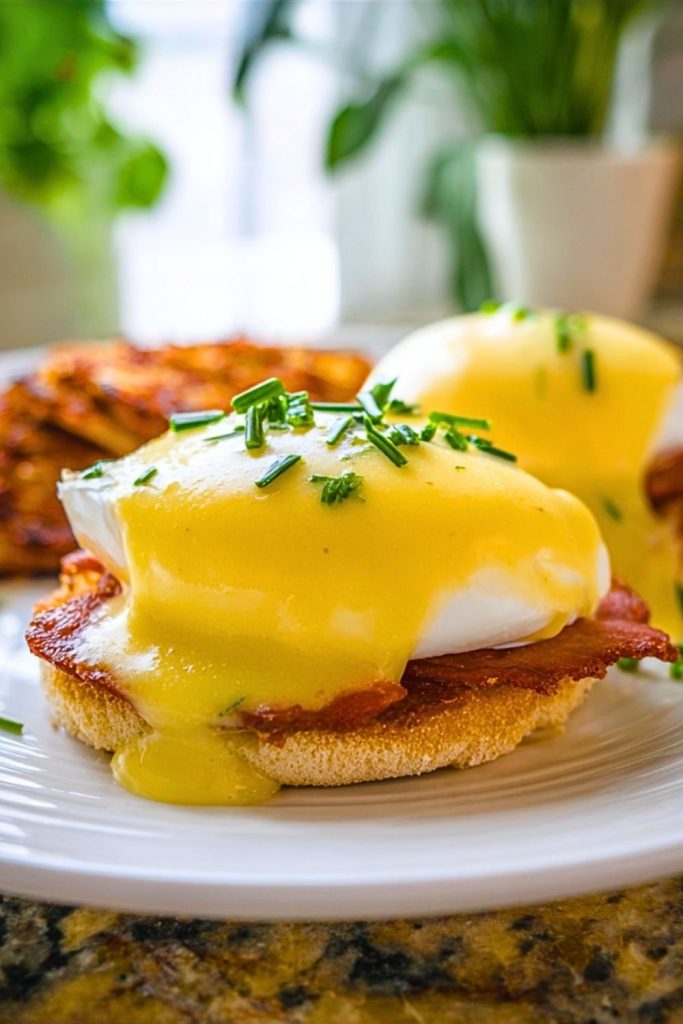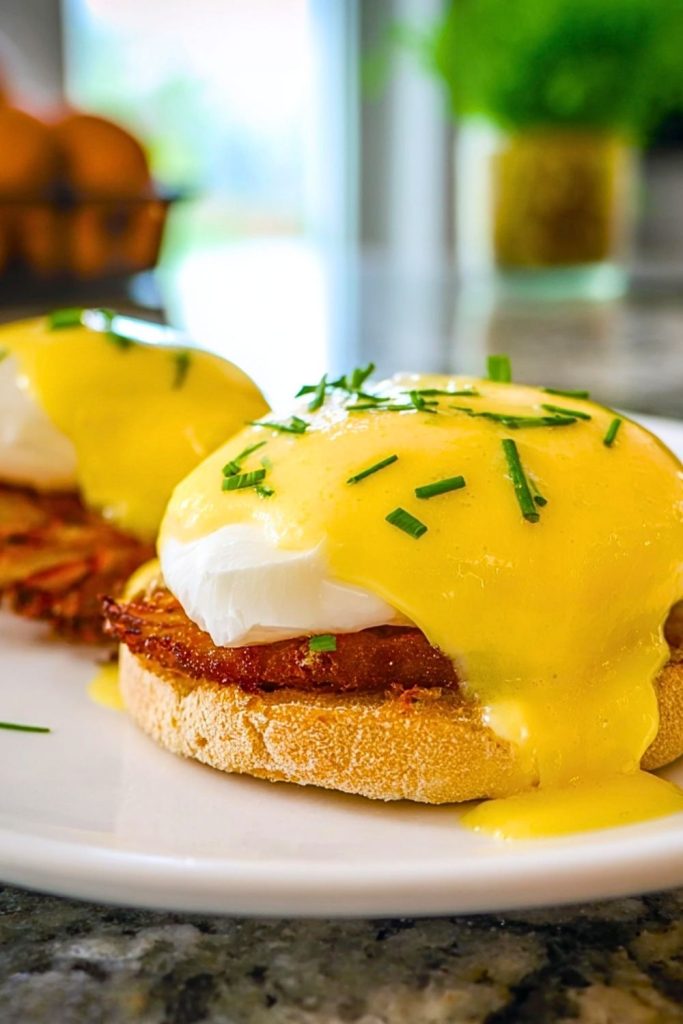Brunch just doesn’t feel complete without the silky luxury of Eggs Benedict. This classic dish has always been one of my favorites — a golden toasted English muffin, topped with crispy Canadian bacon, a perfectly poached egg, and finished with a luscious, lemony hollandaise sauce. The way everything comes together feels like magic on a plate — rich, buttery, tangy, and just the right amount of indulgent.

I still remember the first time I nailed hollandaise sauce from scratch; it felt like a rite of passage in my kitchen journey. Since then, I’ve kept refining and simplifying the process, and now I can confidently say this version of Eggs Benedict is both fail-proof and deeply satisfying. Whether you’re hosting a weekend brunch or just treating yourself, this dish always feels like a celebration.
Why You’ll Love This Eggs Benedict
This isn’t just your average breakfast — it’s a plate of luxury with a homestyle twist. You’ll love how each component brings its own texture and flavor: crunchy muffin base, savory meat, delicate egg, and that silky sauce to tie it all together. It’s comforting, elevated, and incredibly versatile — plus, it’s easier than it looks once you’ve got the steps down.
What Kind of Ham Should I Use for Eggs Benedict?
Traditionally, Eggs Benedict uses Canadian bacon — a lean, slightly smoky cut that crisps up beautifully in a skillet. But if that’s hard to find or not your favorite, thick-cut ham slices work just as well. I’ve even used prosciutto for a more delicate flavor or crispy pancetta when I want something with a bit more crunch. The key is using something salty and meaty enough to balance the creamy hollandaise and the soft egg.
Options for Substitutions
If you’re looking to customize or adapt this recipe to dietary needs or pantry limitations, there’s a lot of flexibility:
- Protein: Swap Canadian bacon for sautéed spinach or avocado for a vegetarian version. Smoked salmon is a great twist if you’re feeling fancy.
- Base: English muffins are classic, but crusty sourdough or sweet potato rounds can make for a creative and gluten-free alternative.
- Hollandaise: If you’re short on time or eggs, a blender version of hollandaise or even a store-bought version can work in a pinch.
- Eggs: Not into poaching? Try a soft-boiled or even a gently fried egg instead. The idea is to keep that runny yolk magic intact.
Ingredients for This Eggs Benedict
English Muffins
These act as the crisp, sturdy foundation. Once toasted, they add a nice crunch that contrasts beautifully with the soft egg and sauce.
Canadian Bacon
Savory and lean, this is the traditional choice that brings a smoky, salty note to the dish. A quick sear gives it the perfect caramelized edge.
Eggs
The heart of the dish. Poached eggs offer that creamy, golden yolk that oozes over everything when cut into.
Unsalted Butter
Essential for making the hollandaise sauce rich and velvety. Using unsalted butter helps you control the seasoning better.
Egg Yolks (for hollandaise)
These are the emulsifying stars of the sauce. They create that thick, silky texture when gently cooked with lemon and butter.
Lemon Juice
Adds brightness and a subtle tang to cut through the richness of the hollandaise.
Salt and Cayenne Pepper
Used to season the hollandaise and enhance all the other flavors.
Fresh Chives
A finishing touch. Chopped chives add a mild onion flavor and a pop of green that makes the dish visually inviting.

Step 1: Toast the English Muffins
Split the muffins and toast them until golden and crisp. Set them on warm plates to keep everything hot during assembly.
Step 2: Sear the Canadian Bacon
In a skillet over medium heat, sear the Canadian bacon slices until they’re nicely browned on both sides. This adds depth and texture. Keep them warm while you prep the rest.
Step 3: Make the Hollandaise Sauce
Melt the butter in a small saucepan. In a separate bowl, whisk together egg yolks and lemon juice, then place over a double boiler or very low heat. Slowly whisk in the melted butter, whisking constantly, until thick and smooth. Season with salt and a pinch of cayenne. Keep warm, but don’t overheat.
Step 4: Poach the Eggs
Bring a pot of water to a gentle simmer and add a splash of vinegar. Crack each egg into a small bowl, then gently lower into the water. Poach for 3–4 minutes, until the whites are set and the yolks remain runny. Use a slotted spoon to lift them out carefully.
Step 5: Assemble the Eggs Benedict
Layer each toasted muffin half with a slice of Canadian bacon, followed by a poached egg. Generously spoon the hollandaise sauce over the top, then garnish with chopped chives. Serve immediately while everything is warm and velvety.
How Long to Cook the Eggs Benedict
From start to finish, this dish takes about 25 to 30 minutes:
- Toasting the muffins: 3–5 minutes
- Cooking Canadian bacon: 4–5 minutes
- Making hollandaise sauce: 7–10 minutes
- Poaching eggs: 3–4 minutes per batch
- Assembly: 2–3 minutes
Planning your timing well helps everything come together while still warm and fresh.
Tips for Perfect Eggs Benedict
- Use fresh eggs for poaching — the whites will hold their shape better.
- Strain the eggs through a fine mesh sieve before poaching to remove watery whites.
- Low and slow is the key for hollandaise. Avoid overheating or rushing it.
- Keep warm components (like toasted muffins and seared bacon) on a tray in a low oven while you poach eggs and finish the sauce.
- Serve immediately — Eggs Benedict doesn’t wait. The longer it sits, the more things cool or soften.
- Add lemon slowly to the sauce — taste and adjust before adding more.
Watch Out for These Mistakes While Cooking
- Overheating the hollandaise sauce: If it gets too hot, it can curdle. Use a gentle double boiler or very low heat, and whisk constantly.
- Skipping vinegar in the poaching water: A splash of vinegar helps the egg whites stay together — don’t leave it out.
- Not drying ingredients before assembly: Wet bacon or dripping eggs can make the muffin soggy. Dab things with a paper towel if needed.
- Rushing the poached eggs: Let them gently poach without stirring or crowding the pot.
- Using cold plates: This dish cools quickly, so warm your plates before assembling.
What to Serve With Eggs Benedict?
1. Crispy Breakfast Potatoes
Seasoned with herbs and garlic, they make the perfect crunchy side to balance the creamy dish.
2. Fresh Fruit Salad
A mix of berries, melon, and citrus adds brightness and freshness to your brunch plate.
3. Sautéed Asparagus or Spinach
Lightly cooked greens add a bit of earthiness and color without overpowering the dish.
4. Smoked Salmon Platter
If you’re making a brunch spread, this adds a luxurious protein option with a cool, briny contrast.
5. Sparkling Mimosa or Fresh-Squeezed Juice
Citrus pairs beautifully with the richness of hollandaise — a little bubbly never hurts either.
6. Buttery Croissants or Scones
Something flaky and delicate to nibble alongside without overshadowing the main dish.
7. Greek Yogurt with Honey and Granola
A lighter option to balance the meal and offer contrast in texture and temperature.
Storage Instructions
Eggs Benedict is best enjoyed fresh, but if you have leftovers, you can store the components separately:
- Poached eggs: Store in cold water in an airtight container in the fridge for up to 2 days. To reheat, gently warm in hot (not boiling) water for about a minute.
- Hollandaise sauce: Keep in a sealed container in the fridge for up to 1 day. Reheat very gently over low heat or in a double boiler while whisking — do not microwave.
- Canadian bacon and muffins: Store in separate containers for up to 3 days. Reheat bacon in a skillet and muffins in a toaster or oven.
Avoid assembling ahead of time — Eggs Benedict loses its texture and appeal once it sits.
Estimated Nutrition
Per serving (1 full muffin with egg, bacon, and sauce):
- Calories: ~410 kcal
- Protein: 18g
- Carbohydrates: 24g
- Fat: 28g
- Saturated Fat: 13g
- Cholesterol: 265mg
- Fiber: 1g
- Sugar: 2g
- Sodium: 720mg
These values can vary depending on the type of bacon, butter, and muffin used, but this gives a good baseline for a classic Eggs Benedict serving.
Frequently Asked Questions
Can I make hollandaise sauce in advance?
You can, but it’s tricky. It’s best served fresh. If needed, make it up to 1 day ahead and reheat very gently over low heat while whisking constantly.
How do I keep poached eggs warm if I’m making a batch?
Place them in a bowl of warm (not hot) water. This keeps them from overcooking and ready to serve when needed.
What’s the easiest way to poach eggs perfectly?
Use fresh eggs, strain them, and gently slide into simmering water with a touch of vinegar. Poach for 3–4 minutes until the whites are set.
Can I use a blender for hollandaise sauce?
Yes, and it’s a great shortcut. Blend egg yolks and lemon juice, then slowly drizzle in hot melted butter while blending until thick and creamy.
Is there a dairy-free version of hollandaise?
You can try using plant-based butter, but the taste and consistency will vary. A vegan cashew-based “hollandaise” is another alternative.
Can I use something other than English muffins?
Definitely. Sourdough toast, biscuits, or even potato cakes are great alternatives.
Why is my hollandaise sauce breaking?
It usually means it got too hot or the butter was added too fast. Whisk in a teaspoon of hot water to bring it back together.
Can I freeze Eggs Benedict?
Not recommended. The textures of poached eggs and hollandaise don’t hold up well after freezing and thawing.
Conclusion
Eggs Benedict might seem like a restaurant-only dish, but with a little practice and the right steps, it becomes an incredibly rewarding recipe to master at home. It’s all about timing and balance — crisp base, savory meat, silky egg, and rich sauce. Whether you’re hosting a brunch or just treating yourself, this dish always brings a little extra joy to the table.

Eggs Benedict
- Prep Time: 10 minutes
- Cook Time: 20 minutes
- Total Time: 30 minutes
- Yield: 2 servings
- Category: Breakfast
- Method: Poaching
- Cuisine: American
Description
A classic brunch favorite, this Eggs Benedict recipe combines toasted English muffins, savory Canadian bacon, perfectly poached eggs, and a rich homemade hollandaise sauce. Each component layers together into a luxurious and satisfying dish that’s both elegant and approachable.
Ingredients
2 English muffins
4 slices Canadian bacon
4 large eggs
1 tablespoon white vinegar
1/2 cup unsalted butter
3 egg yolks
1 tablespoon lemon juice
1/4 teaspoon salt
1 pinch cayenne pepper
1 tablespoon chopped fresh chives
Instructions
1. Split and toast the English muffins until golden and crisp.
2. In a skillet over medium heat, sear the Canadian bacon until browned on both sides. Keep warm.
3. Melt butter for the hollandaise. In a bowl, whisk egg yolks and lemon juice. Set over low heat or a double boiler and slowly whisk in the melted butter until thick. Season with salt and cayenne.
4. Bring a pot of water to a gentle simmer and add vinegar. Crack eggs into small bowls and gently poach for 3–4 minutes.
5. Layer each toasted muffin half with a slice of Canadian bacon, then a poached egg. Spoon hollandaise sauce generously on top.
6. Garnish with chopped chives and serve immediately.
Notes
Use very fresh eggs for best poaching results.
Keep all components warm until ready to assemble.
Hollandaise sauce can break if overheated — keep heat low and whisk constantly.
Nutrition
- Serving Size: 1 full muffin with toppings
- Calories: 410
- Sugar: 2
- Sodium: 720
- Fat: 28
- Saturated Fat: 13
- Unsaturated Fat: 12
- Trans Fat: 0
- Carbohydrates: 24
- Fiber: 1
- Protein: 18
- Cholesterol: 265
Keywords: Eggs Benedict, brunch, hollandaise sauce, poached eggs

